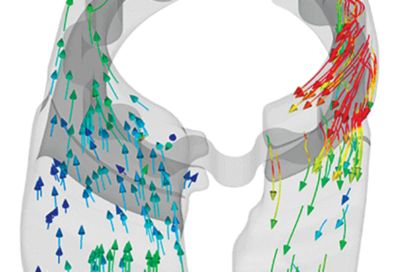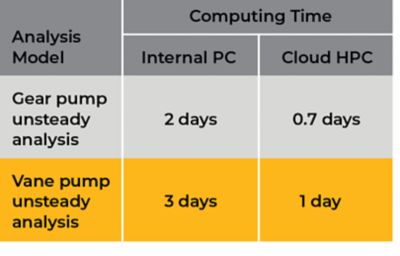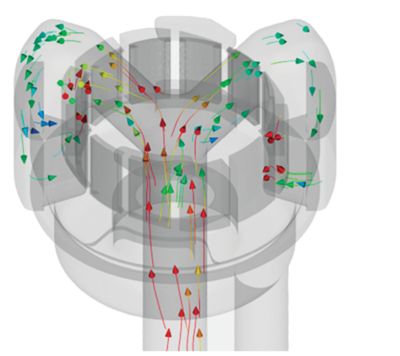ANSYS ADVANTAGE MAGAZINE
DATE: 2020
Fast Fluid Simulation on the Cloud
By Ansys Advantage Staff
Mazda Motor Corporation develops vehicles efficiently by incorporating model-based computer-aided engineering (CAE). Toyo Advanced Technologies, a spinoff of Mazda, engineers, manufactures and supplies oil pumps for automatic transmissions mounted in automobiles equipped with Mazda’s SKYACTIV technologies, which increase fuel efficiency and engine output. The company also produces fuel rails, which transfer fuel to each cylinder of an engine. To survive in the auto parts industry, where competition is heating up globally, a high-performance product must be developed quickly to meet clients’ schedules and requirements. To perform analyses rapidly and affordably, Toyo Advanced Technologies engineers used Ansys Fluent via a cloud service for model-based CAE, instead of installing a high-performance computing (HPC) system in their own facility.
Simulation Is Key
“There is no doubt that CAE is necessary,” says Mitsunobu Matsuda, manager of the Automotive Components Engineering Department of Toyo Advanced Technologies, which includes sales, design, testing and production technology. “Without CAE, we are unable to meet fast-growing demands from clients.”
Computing time comparison before and after cloud HPC implementation
In the case of an oil pump, technical requirements such as discharge volume and size are submitted by a client. Engineers estimate the part shape and size based on the technical requirements to achieve the client’s goals. According to Matsuda, engineers are not good at such goal-oriented estimation if a synergistic effect or interaction is involved.
“什么工程师擅长正在泵a shape temporarily determined by simple calculations, testing it and then repeating the steps based on the results until the client’s specifications are met,” Matsuda says. “This process is very easy but does not satisfy the client. Only one correct, goal-oriented estimation leads to the best solution. CAE can perform this estimation instead of engineers. This is one of the benefits of CAE.”
作为一个协同效应的例子或interaction, Tetsuya Okimoto from Toyo’s Automotive Components Development Division cites hydraulic pressure. “The pulsation of hydraulic pressure generated by the pump depends on hydrodynamics, with factors such as the pump specifications, the shape of the hydraulic pressure supply destination and the volume,” he says. However, because pulsation includes the interaction of these different variables, the calculation formula is complicated. “Therefore, the only means for calculating this pulsation is CAE,” Okimoto says. “We succeeded in calculating this using Ansys Fluent.”
Keeping Pace With Clients
Toyo Advanced Technologies decided to use CAE for single-phase fluid flow and multiphase flow with cavitation in 2012 to decrease development time. In the summer of 2017, the company introduced Fluent to further improve the efficiency of pump development. The Automotive Components Engineering Department replaced its conventional analysis tool with Fluent to take advantage of its high-accuracy pump analysis models and the company’s highly acclaimed technical support. “We read another company’s report on a pump that said an Ansys development tool was used, so we contacted Ansys for benchmarking,” says Okimoto. “Actual data was so closely replicated by simulation in the benchmark test, and Ansys’ technical support service level was so high, that we decided to implement the software.”
Ansys Cloud Convenience
Ansys customers like Toyo Advanced Technologies have several options to incorporate high-performance computing into their simulation workflows. One convenient option is Ansys Cloud.
Ansys Cloud makes it seamless, easy and cost-effective to harness the full power of Ansys simulation software on an as-needed basis — enabling fast, flexible access to the processing capabilities needed to run large simulations or multiple, full-featured simulations faster. Ansys has partnered with Microsoft to provide access to the Microsoft Azure cloud computing platform from within Ansys applications.
No cloud environment configuration is needed because Ansys Cloud is optimized for Ansys software, and hardware configurations are preconfigured. Ansys Elastic Units (AEUs) can be used on-premise and on the cloud, allowing customers the flexibility to make the most of their hardware and software resources.
The Azure platform follows Microsoft’s security best practices, which include third-party auditing. Users can easily monitor the progress of their simulation from within the Ansys application, or from a web-based cloud portal.
If you’d like to try Ansys Cloud for free, visit ansys.com/freecloudtrial.
“There is no doubt that CAE is necessary. Without CAE, we are unable to meet fast-growing demands from clients.”
— Mitsunobu Matsuda, Toyo Advanced Technologies
Cloud Speeds Analysis, Reduces Cost
Toyo Advanced Technologies ran Ansys Fluent on an internal PC for a while after implementation.
Though they were satisfied with the analysis accuracy of Ansys Fluent, a pump fluid analysis sometimes took three days, even on a computer with 24 cores.
“It is not just about the accuracy of computing results. Who wants to use software that takes three days to process?” asks Matsuda. “So, we searched for a solution to this problem and found a cloud service.”
The company could have built an HPC server internally to speed up analysis, but that would have required a substantial initial investment as well as continued investments in operation and management. Considering the company’s size and software use frequency, they decided to use a cloud service. Another deciding factor was that letting a cloud service manage the hardware enabled engineers to concentrate on analysis tasks instead of system operation and maintenance.
The company started using Rescale Japan’s cloud HPC service in early 2018 to increase its analysis speed.
经过确认流利的将工作本身rvice, it took about two weeks from when the budget for service implementation was approved to when the service became available. Toyo Advanced Technologies started using 128 cores via Rescale Japan, as well as its internal PC with 24 cores. This successfully reduced the analysis time by 66% — from three days to one. It takes 30–60 minutes to download analysis results, but using a cloud service is far more cost-effective than installing an HPC server internally.
Reducing Development Time and Prototypes
The Automotive Components Engineering Department’s goal is to develop a pump that satisfies their client’s requirements within three months. Ideally, that includes three weeks of concept design for a rough structure, two weeks of detailed design for the actual part shape and size, about a month for prototyping, and two or three weeks confirming that the prototype meets the requirements. However, it used to take six to seven weeks just for concept design, which caused a bottleneck. Running Fluent on a cloud HPC service successfully reduced the concept design time to fit into its three-week window.
Fluent simulations also reduced the number of prototypes created at each development stage. In the parts development stage of pump design, Toyo Advanced Technologies reduced both the number of prototypes and costs by up to one-third using simulation. In the light of such results, employees now say: “Why make prototypes? We have CAE.”
Matsuda is thinking about further improving the analysis accuracy so that Ansys Fluent can be used for new product development. This would involve determining the direction of a basic pump structure in the concept design phase and optimizing its shape. Then, in the detailed design phase, he would like to estimate the performance of an optimized shape.
“We would like to be a supplier who gives the first priority to solving client problems,” says Matsuda. “The happiest thing as an engineer is being the first one called on by clients whenever they have problems.”
More Than 90 Years of History
The history of Toyo Advanced Technologies dates back to 1929, when the company began producing grinding machines as a department of Mazda Motor Corporation (then Toyo Kogyo Company Limited). Dealing in machine tools and automotive components, the company spun off from Mazda Motor Corporation in 1989 to become Toyo Advanced Technologies Company Limited. Their main business is in machine tools, specifically internal grinding machines, for which they have the leading market share in Japan. They also have a metal coating business, which offers special coatings for molds and tools, and an automotive components business, which develops, manufactures and sells automatic transmission unit oil pumps and fuel rails for fuel supply equipment.
SALES: 24 billion yen, about $220 million (fiscal year ended March 2018)
PAID-IN CAPITAL: 3 billion yen, about $25.5 million (as of March 2018)
NUMBER OF EMPLOYEES: 625 (as of March 2018)
















